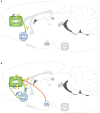Optogenetic dissection of medial prefrontal cortex circuitry
- PMID: 25538574
- PMCID: PMC4260491
- DOI: 10.3389/fnsys.2014.00230
Optogenetic dissection of medial prefrontal cortex circuitry
Abstract
The medial prefrontal cortex (mPFC) is critically involved in numerous cognitive functions, including attention, inhibitory control, habit formation, working memory and long-term memory. Moreover, through its dense interconnectivity with subcortical regions (e.g., thalamus, striatum, amygdala and hippocampus), the mPFC is thought to exert top-down executive control over the processing of aversive and appetitive stimuli. Because the mPFC has been implicated in the processing of a wide range of cognitive and emotional stimuli, it is thought to function as a central hub in the brain circuitry mediating symptoms of psychiatric disorders. New optogenetics technology enables anatomical and functional dissection of mPFC circuitry with unprecedented spatial and temporal resolution. This provides important novel insights in the contribution of specific neuronal subpopulations and their connectivity to mPFC function in health and disease states. In this review, we present the current knowledge obtained with optogenetic methods concerning mPFC function and dysfunction and integrate this with findings from traditional intervention approaches used to investigate the mPFC circuitry in animal models of cognitive processing and psychiatric disorders.
Keywords: addiction; cognition; depression; fear; memory; optogenetics; prefrontal cortex.
Figures


References
Publication types
LinkOut - more resources
Full Text Sources
Other Literature Sources

